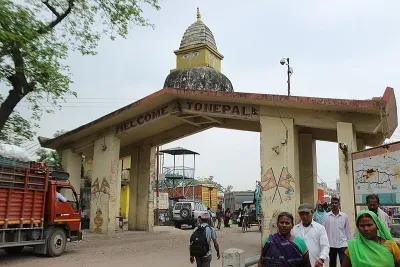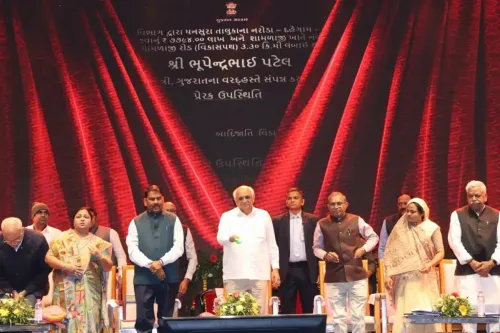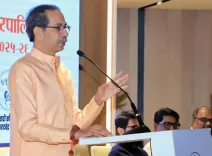Did IIT-Kanpur Uncover Signs of Ancient Buddhist Stupas in Haryana?

Synopsis
Key Takeaways
- IIT Kanpur's discovery could reshape regional history.
- Evidence suggests structures may date back 2,000 years.
- Advanced GPR technology was utilized for non-invasive exploration.
- Potential links to ancient Buddhist settlements are being explored.
- Further investigations are planned with the Haryana archaeology department.
Kanpur, July 16 (NationPress) In a groundbreaking scientific discovery that could reshape regional history, a research team from the Indian Institute of Technology (IIT) Kanpur has identified indications of ancient Buddhist stupas and structural remnants buried in the soil of Yamuna Nagar district, Haryana.
The team employed advanced Ground Penetrating Radar (GPR) technology, uncovering circular formations, ancient walls, and chamber-like spaces at depths of approximately 6 to 7 feet, suggesting the existence of a Buddhist site dating back around 2,000 years.
This survey was commissioned by the Haryana State Department of Archaeology as part of a larger effort to locate potential historical structures in various locations, including Topra Kalan and other villages known for their scattered ancient bricks.
The findings from the IIT Kanpur team present compelling evidence of buried heritage that may be linked to the Buddhist era or even the Mahabharata period, as per local traditions.
Professor Javed Malik, who spearheaded the project from IIT Kanpur’s Civil Engineering Department, stated, “We have collaborated with the Archaeological Survey of India (ASI) on similar endeavors for many years. With our expertise in detecting subsurface structures, the Haryana archaeology department sought our assistance to investigate three key sites, aiming to validate anecdotal claims of ancient materials found above ground.”
During their investigation, the researchers utilized GPR to examine the ground without excavation.
“We started observing inclined reflections indicative of well-aligned, intentional structural features,” Malik elaborated.
“These might represent ancient walls, small cells, or even entire living spaces.”
One of the most promising locations explored was Topra Kalan in Yamunanagar, a village renowned for an ancient temple on a significant mound. Although the team was unable to conduct GPR scans inside the temple, they surveyed the vicinity.
“Upon examining the mound’s exterior, we detected strong geo-radar reflections suggesting a semi-circular structure beneath,” Malik remarked.
“Archaeological officials confirmed the presence of what they believed was a stupa nearby. Our findings aligned with the belief that we were indeed identifying a buried stupa.”
In addition to Topra Kalan, the team explored a second site known locally as 'Jarasandha ka Qila,' named after the mythical figure from the Mahabharata.
“It’s a captivating site. The villagers continue to observe ancient customs there, including throwing stones as part of local rituals. We conducted surveys atop this mound as well. While the reflections were not perfectly semi-circular, they strongly indicated a circular structure beneath the surface, consistent with a potential stupa,” Malik noted.
The findings have sparked significant interest among archaeologists, historians, and local officials. As per Malik, samples from these sites have already been dispatched for scientific dating.
“Once the dating is completed, we will be better positioned to determine whether these structures belong to the Buddhist era or another ancient culture,” he added.
“If the Archaeological Department provides formal approval, we can commence proper excavations.”
This discovery could revolutionize our understanding of Haryana’s ancient history and establish new connections within India’s extensive Buddhist heritage. Malik emphasized that while the current evidence is highly promising, formal archaeological excavation will be crucial in ascertaining the age, scope, and cultural significance of these finds.
“Our research hints at the possibility of a larger Buddhist settlement or circuit in this area,” Malik said.
“Though the structures are presently visible only at select locations, should further surveys and excavations reveal a widespread pattern, it could illustrate how far this culture once extended and thrived.”
He also underscored the broader implications of this research: “This would be a monumental discovery not only for Haryana but for all of India. Confirming the existence of Buddhist settlements here will enhance our understanding of ancient trade routes, religious networks, and cultural exchanges that shaped the subcontinent.”
The IIT Kanpur team is in close collaboration with the Haryana archaeology department to plan additional surveys and studies at further sites.
As Malik concluded, “We remain hopeful that ongoing dating and future excavations will validate the significance of these structures. This could serve as a remarkable testament to the people of India, uncovering yet another layer of our extraordinary heritage hidden just beneath our feet.”










